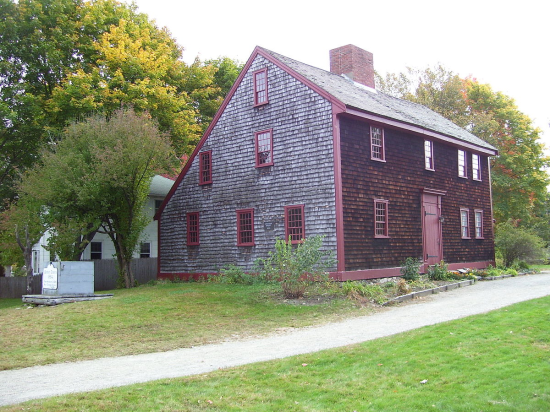Missing!
Parker Tavern Reading MA

Many of the Massachusetts Bay Colony's original settlers arrived from England in the 1630s through the ports of Lynn and Salem. In 1639 some citizens of Lynn petitioned the government of the colony for a "place for an inland plantation". They were initially granted six square miles, followed by an additional four. The first settlement in this grant was at first called "Lynn Village" and was located on the south shore of the "Great Pond", now known as Lake Quannapowitt. On June 10, 1644 the settlement was incorporated as the town of Reading, taking its name from the town of Reading in England.
The first church was organized soon after the settlement, and the first parish separated and became the town of "South Reading" in 1812, renaming itself as Wakefield in 1868. Thomas Parker was one of the founders of Reading. He also was a founder of the 12th Congregational Church (now the First Parish Congregational Church), and served as deacon there. He was a selectman of Reading and was appointed a judicial commissioner. There is evidence that Parker was "conspicuous in naming the town" and that he was related to the Parker family of Little Norton, England, who owned land by the name of Ryddinge.
A special grant in 1651 added land north of the Ipswich River to the town of Reading. In 1853 this area became the separate town of North Reading. The area which currently comprises the town of Reading was originally known as "Wood End", or "Third Parish".
The Parker Tavern, built 1694, is the oldest surviving building in Reading. It was owned and operated by Ephraim Parker, who was the great-grandson of Thomas Parker, who was one of the founders of Reading and probably named the town. The tavern is now a museum.
The town of Reading was initially governed by an open town meeting and a board of selectmen, a situation that persisted until the 1940s. In 1693, the town meeting voted to fund public education in Reading, with grants of four pounds for three months school in the town, two pounds for the west end of the town, and one pound for those north of the Ipswich River. In 1769, the meeting house was constructed, in the area which is now the Common in Reading. A stone marker commemorates the site.[2]
Reading played an active role in the American Revolutionary War. It was prominently involved in the engagements pursuing the retreating British Army after the battles of Lexington and Concord. John Brooks, later to become Governor of Massachusetts, was captain of the "Fourth Company of Minute" and subsequently served at the Battle of White Plains and at Valley Forge. Only one Reading soldier was killed in action during the Revolution; Joshua Eaton died in the Battle of Saratoga in 1777.
In 1791, sixty members started the Federal Library. This was a subscription Library with each member paying $1.00 to join, and annual dues of $.25. The town's public library was created in 1868.
CLICK HERE! to check out all Reading active listings.
Town's web page: https://www.readingma.gov/
Source:Wikipedia
2023FairHousingMonthPoster18x24.pdf